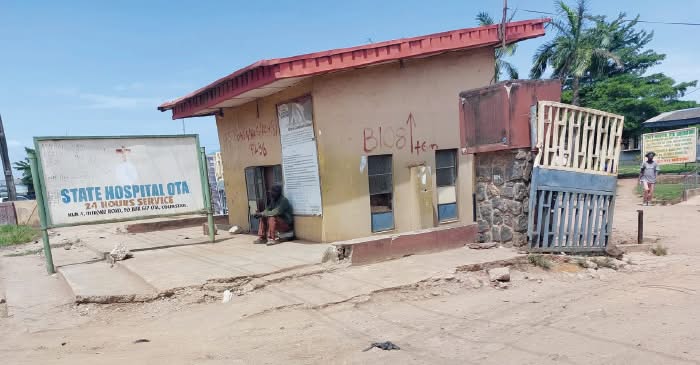Ota General Hospital in Ogun State, the primary public healthcare facility serving over two million residents of Ado-Odo Ota and surrounding communities, has become a troubling symbol of neglect and decay. Patients who rely on this institution daily are forced to endure a grim environment marked by filth, malfunctioning equipment, and inadequate power supply, turning what should be a place of healing into a source of distress. An undercover investigation by Sodiq Ojuroungbe reveals the disturbing realities faced by patients trapped in this crumbling facility.
From a distance, Ota General Hospital projects an image of hope. The tall, solid buildings and ongoing construction of new wings, including a modern Intensive Care Unit, suggest a healthcare center poised to provide quality medical care. The façade paints a picture of progress and organization, appearing like any other government hospital aspiring for modernity.
Yet, this impression quickly fades upon closer inspection. The hospital’s grounds are littered with dirt and debris, while neglected bushes and weeds encroach upon the property, casting shadows of neglect. It is as though the polished exterior masks a deeper rot hidden within.
Inside the hospital, the situation worsens. Patients are immediately greeted by a strong, unpleasant odour, a nauseating mix of stale air and decay, that lingers in the corridors. Walls that were once white are now coated with grime, paint peeling off to reveal cracked surfaces begging for repair. Patients lie on battered beds with misshapen mattresses or sit on hard wooden benches, their faces reflecting worry and discomfort.
The lack of electricity intensifies the distress. Except for a few computers in the administrative block powered sporadically by solar panels and a noisy generator, most parts of the hospital are plunged in darkness. Flickering fluorescent lights are a rarity, forcing patients to endure the oppressive Nigerian heat without fans or air conditioning. Ceiling fans, thick with dust and cobwebs, hang idle. Cracked plaster reveals years of abandonment while floors are strewn with litter and dust, a clear sign of chronic neglect.
The chaotic atmosphere is far from the sterile, orderly environment expected of a healthcare facility. Patients crowd the wards and waiting areas, shoulder to shoulder, sweating under the unrelenting heat. The heavy, humid air makes the wait unbearable, and the disorganization is palpable, no queues, no clear system, and very few staff to guide the desperate crowd.
Determined to expose the truth, the reporter went undercover as a patient suffering severe abdominal pain. Upon arrival, he encountered indifferent health workers engaged in idle conversation, seemingly indifferent to the suffering around them. The absence of a structured process meant no one took immediate responsibility for attending to him. Nurses and staff appeared uninterested, offering no guidance or empathy.
Eventually, a compassionate woman directed him to the registration desk. Despite signage clearly stating “Cash Payment Not Allowed,” he was quietly charged N1,500 to obtain a hospital card. The payment was taken without receipt or any inquiry into his condition.
The registration clerk offered no information on the next steps, leaving the patient to wait among a restless crowd for nearly an hour. Frustrations bubbled over as some patients shouted in anger while others wept quietly. After the long wait, a young house officer called him into a small consulting cubicle.
The consultation room was a stark disappointment, constructed from thin aluminum sheets, cramped to barely fit two chairs and a small desk holding a solitary computer. Posters with faded drug information clung to peeling walls, and a foul stench pervaded the air, forcing the reporter to repeatedly cover his nose.
After a brief consultation, the doctor directed him to lie down on an examination bed located in a narrow corridor beside the cubicle. The bed was filthy, covered in dirt, grime, and scattered medical waste, despite a waste bin standing nearby. Its rusty metal frame groaned under weight, the mattress stained and torn, offering little comfort or hygiene. The windowpanes were coated in thick dust, blocking natural light and creating a suffocating atmosphere.
The doctor’s examination was cursory at best. With no diagnostic tests or thorough assessment, the young physician quickly concluded the patient was suffering from an ulcer. He prescribed medications, Gaviscon and Peptikit, without further investigations, leaving the patient to question the quality of care.
This investigation exposes how Ota General Hospital, instead of being a haven for the vulnerable, has become a place where neglect and systemic failure compound patients’ suffering. The filth, poor infrastructure, and substandard medical attention raise urgent questions about the state of public healthcare in Ogun State and the need for immediate reforms to protect millions who depend on this institution for their well-being.
